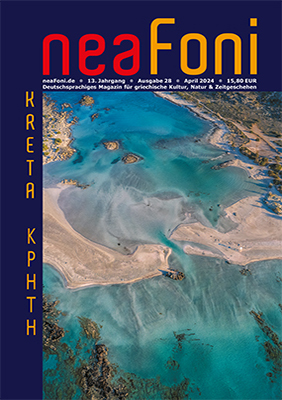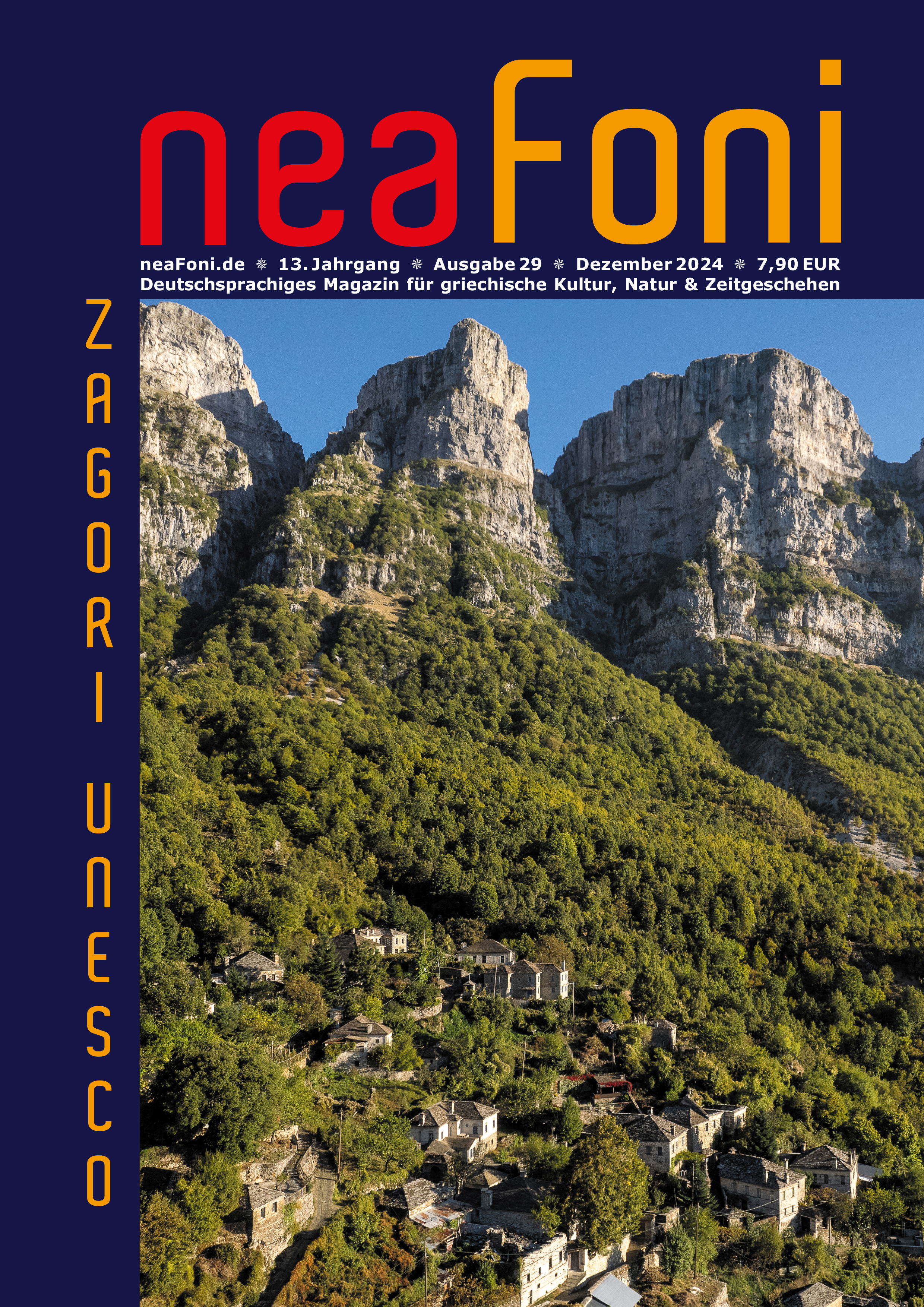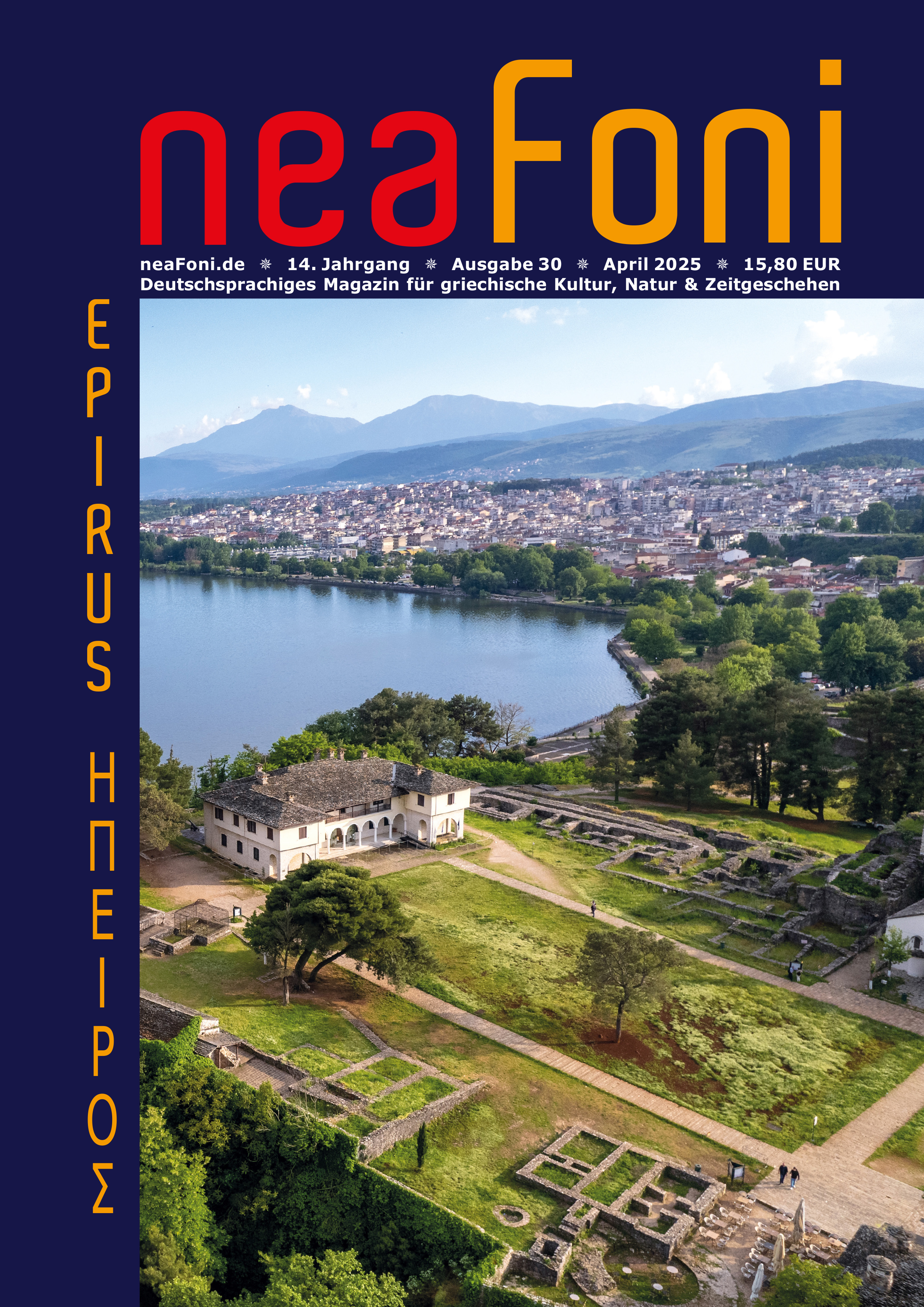Zu den Meisterwerken der frühchristlichen Architektur zählt die Panagia Hekatontapyliani, die „Hunderttorige“, ein Beiname, der wohl als „eine Anspielung auf ihre ungewohnt vielen Fenster“ zu verstehen ist. Sie liegt am Rand der Altstadt Parikia auf der Kykladeninsel Paros. Ein Beiname allerdings, der auch zu Spekulationen Anlass gibt, denn die der Gottesmutter geweihte Basilika, das Wahrzeichen der Insel Paros, wird bisweilen auch als Panagia Katapoliani bezeichnet, was so viel wie „die Gottesmutter der unteren Stadt“ bedeutet. Bezogen auf den ersten Beinamen „Hekatontapyliani“, „die Hunderttorige“, hat sich im Volksmund eine Legende herausgebildet, der zufolge „man bislang nur 99 Türen zählen konnte. Wenn die Hundertste gefunden werde, so sagt man, werde Konstantinopel wieder zu Griechenland gehören“ (Hertha Schwarz). Die Basilika kann in einem Atemzug mit so berühmten frühchristlichen Bauten wie der Hagia Sophia in Istanbul, der Basilika San Vitale in Ravenna oder der Johannesbasilika in Ephesos an der türkischen Westküste genannt werden. Der gewaltige Kirchenkomplex erscheint nach außen eher schlicht und ist von einem zweistöckigen Pilger- und Verwaltungsgebäude umgeben. Der Komplex erhebt sich majestätisch im Hafengebiet von Paros in der Nähe der antiken Agora, dort wo einst ein römisches Gymnasium stand, und besteht aus einem Vorhof, der Hauptkirche mit der kleinen Nikolaos-Kapelle im Nordosten sowie der heute als Sakristei genutzten Kapelle der Heiligen Kosmas und Damian im Südosten und dem anschließenden Baptisterium im Süden.
Der Bau steht an einer Stelle, an der schon vorher eine Basilika existierte, die der Legende nach von Helena (248/50 – um 330), der Mutter des Kaisers Konstantin, gestiftet worden war. Dieser Legende zufolge soll Helena auf ihrer Reise nach Jerusalem bei schwerem Sturm in die Bucht von Parikia geraten und dort an Land gegangen sein, um hier aus Dankbarkeit für die Rettung aus Seenot der Jungfrau Maria eine Basilika zu weihen. Aus dieser Kirche der Kaisermutter ist die heutige Panagia Hekatontapyliani hervorgegangen, die Erica Wünsche so beschreibt: „Wie eine in Stein geschriebene Kunstgeschichte vermittelt sie ein Bild von der Architektur des ersten Jahrtausends, der Veränderung in Bauwillen und Baustil von frühchristlicher Zeit bis zur mittelbyzantinischen Epoche.“
Die Panagia Hekantontapyliani wurde nach dem 2. Weltkrieg von dem Byzantinologen Professor Anastasios Orlandos gründlich restauriert und von allem späteren Schnickschnack befreit. Sie blickt auf eine lange und komplizierte Baugeschichte zurück, wurde schon im 9. Jh. gebrandschatzt und mehrfach umgebaut. Im 18. Jh. wurde der Bau durch ein Erdbeben beschädigt, danach teilweise sogar barockisiert und übertüncht. Ein Blick auf ihren Grundriss zeigt die großzügige Konzeption der Inselkirche und lässt erahnen, welchen Platz sie im Konzert der frühchristlichen Kirchenbauten neben Konstantinopel, Rom, Thessaloniki und Ravenna einnimmt. Im Inneren erlebt der Besucher vor allem den enormen Raumeindruck, den dieser basilikale Bau ausstrahlt und der jeden Betrachter tief beeindrucken muss.
Nach Ansicht der Forschung ist der älteste Bau dieses Komplexes die Nikolaos-Kapelle im Nordosten. Sie wurde als dreischiffige frühchristliche Basilika mit Holzdach errichtet und kann demnach mit der Helena-Legende verbunden und infolgedessen ins 4. Jh. n. Chr. datiert werden. Die heutige Apsis und das Synthronon stammen noch aus dieser Zeit. Ansonsten wurde der Bau unter dem byzantinischen Kaiser Justinian im 6. Jh. n. Chr. verändert und in eine kuppelgekrönte Emporenbasilika verwandelt. Je drei monolithe antike Säulen trennen die sehr eng geführten Seitenschiffe vom Hauptschiff, sodass sich ein relativ breites Mittelschiff ergibt. Ein Architekturmotiv, das auf eine frühe Entstehung des Baus hindeutet und als beliebtes Raummotiv frühchristlicher Basiliken in Griechenland auftaucht, aber auch bei den ravennischen Basiliken zu bemerken ist. Man denke an die Basilika San Giovanni Evangelista aus dem 5. Jh. n. Chr., die wir mit Galla Placidia (392-450 n. Chr.) verbinden und die in ihrem Inneren genau dieses Motiv zeigt. Bereits die frühchristliche Basilika des 4. und 5. Jhs. n. Chr. hatte ein derartiges Raumgefühl entwickelt. Beispiele in Ravenna und anderswo belegen dies. Darüber hinaus ist es interessant, wie unter Kaiser Justinian, der im Byzantinischen Reich eine rege Bautätigkeit entfachte, ein neuer, in der Hauptstadt entstandener Baugedanke auf der Kykladeninsel Paros in die Tat umgesetzt und die Verbindung von Zentral- und Langhausbau Wirklichkeit wurde. Dies geschah hier übrigens in sehr einfacher, aber plausibler Form, indem die Basilika vor dem Chorjoch mit einer Kuppel überhöht wurde. Dabei wurde außerdem der Altarraum durch einfache Marmorschranken abgegrenzt, wie dies bei allen frühchristlichen Basiliken üblich war. Später wurden diese Marmorschranken durch eine Ikonostasis ersetzt. Die von Demetrius signierte Marienikone mit der Beischrift >Eleousa< und das Pantokratorbild aus dem 17. Jh. an der Ikonenwand sind gleichfalls Zeugen dieser langen Kirchentradition. Zu dem Bildzyklus gehört auch die heute im Kircheninneren aufbewahrte Ikone der >Panagia Hekatontapyliani<, die von Professor Orlandos ins 18. Jh. datiert wurde und auf der die Jungfrau Maria über einem Segelschiff in wellenbewegter See als „Hodegetria“, als „Wegweisende“, dargestellt ist. Heute wirkt die nur 10 m lange Nikolaos-Kapelle eher „wie ein Beiboot neben dem Mutterschiff“ (Erica Wünsche).
Die Hauptkirche dieses Komplexes ist der Panagia, der Gottesmutter, geweiht und misst 30 x 25 m, was „für Inselverhältnisse groß“ ist. Sie ist eine tonnengewölbte Kuppelbasilika mit angedeutetem Querschiff und geht in dieser Form wohl auf die Zeit des byzantinischen Kaisers Justinian zurück, also in die Jahre zwischen 527 und 565 n. Chr. Der Grundriss zeigt die Form eines freien Kreuzes, wobei jedes Kreuz dreischiffig ist und nur der östliche Kreuzarm eine Ausnahme bildet. Der Neubau war erforderlich geworden, nachdem die Vorgängerkirche bei einem Brand stark beschädigt worden war. Beim Wiederaufbau wurde der alte Grundrissplan größtenteils beibehalten, der Bau jedoch mit einem neuen Dachabschluss versehen. Eine Maßnahme, die wohl mehr dem Zeitgeist der justinianischen Zeit geschuldet war. Einige Forscher vermuten deshalb ein Holzdach als Dachabschluss der Vorgängerkirche. Das entsprach weitgehend der Überdachung der Nikolaos-Kapelle. Beim Wiederaufbau der Basilika unter Justinian wurde der Mittelraum mit einer flachgedrückten Kuppel versehen, die Seitenarme dagegen tonnengewölbt. Damit hatten sich Hauptraum und Nikolaos-Kapelle in ihrer Dachkonstruktion einander angepasst und bildeten eine architektonische Einheit. Der Altarraum mitsamt dem Synthronon behielt seine frühchristliche Form und fügt sich nahtlos in den Raum der Basilika ein. Das Ziborium ist aus Marmor, wie es sich für eine Marmorinsel gehört, und stand immer an diesem Platz, heute allerdings verborgen hinter der später entstandenen, wohl im 9. Jh. nach dem Bilderstreit errichteten Ikonostasis. In ihrem unteren Wandbereich war die Basilika mit Marmorinkrustationen ausgestattet, die Gewölbe hingegen waren durch grüne, gelbliche und rote Streifen gegliedert, zeigten also einen ziemlich aufwendigen Dekor. Dessen Wirkung beherrschte den großzügig angelegten Kirchenraum, ging später allerdings in dieser Form verloren, als die Wände des Altarraums und große Teile der Kirche mit Wandmalereien versehen wurden. Einige der Wandmalereien aus dem 16. Jh. sind in der Nikolaos-Kapelle zu sehen, viele wurden größtenteils bei dem Erdbeben des 18. Jhs. beschädigt. Nur Teile konnten geborgen werden, in den Gewölbezwickeln, wo Cherubim dargestellt sind, und im Altarraum, wo die Malereien den in 24 Bildern dargestellten und in 24 Strophen gesungenen Akathistos-Hymnos, einen besonderen Lobgesang auf die Gottesmutter, zeigen. Heute gibt die Basilika nach den umfangreichen Restaurierungsarbeiten durch Professor Orlandos zum größten Teil den Zustand des justinianischen Baus wieder, dessen Architekturelemente für sich sprechen und in ihrer Schlichtheit sowie in ihrer klaren Formensprache jeden Besucher beeindrucken. Frühchristliches Formengut erreichte hier einen ersten Höhepunkt und die Basilika erfuhr ein neues Raumgefühl, das die Panagia Hekatontapyliani zu einem wahren Architekturjuwel der Frühzeit werden lässt. Damit reiht sich die Basilika von Paros in jenen Reigen der justinianischen Bauten des 6. Jhs. n. Chr. ein, die in Konstantinopel, Ephesos und Ravenna errichtet wurden: die Hagia Sophia in Konstantinopel, die Johannes-Basilika auf dem Hügel Ayasoluk in Ephesos und die Basilika San Vitale in Ravenna, um nur einige Bauten zu nennen.
Wie schon angedeutet, ist der Altarraum heute statt durch niedrige Marmorschranken durch eine Ikonostasis aus Marmor als eigener Raum vom basilikalen Hauptschiff abgetrennt und steht somit in der orthodoxen Tradition. Zu erwähnen bleibt noch, dass die drei wertvollen Hauptikonen mit Verkleidungen aus Silber abgedeckt sind, die Nikolaos Mavrogenis (1738-1788), ein Grieche und hoher Beamter am osmanischen Hof, 1788 gestiftet hatte. Mavrogenis blieb zeitlebens seiner Heimatinsel sehr verbunden und stiftete auch einige Brunnen, die noch heute in der Altstadt von Paros zu bewundern sind. Die Marienikone nimmt in der Reihe der Hauptikonen einen besonderen Platz ein und steht mit den übrigen wertvollen Hauptikonen bei feierlichen Prozessionen an Marien- und Osterfeiertagen im Mittelpunkt des liturgischen Geschehens.
An der Südseite der Hekatontapyliani liegt das zeitgleich entstandene Baptisterium mit einem kreuzförmigen, tiefen Marmorbecken im Zentrum. Das Baptisterium ist Johannes dem Täufer geweiht und gehört zu den wenigen erhaltenen Taufkirchen aus der Zeit des frühen Christentums in Griechenland. Wie die Basilika, überzeugt auch das Baptisterium durch eine klare und schlichte Architektursprache mit nur wenigen, prägnant gesetzten Akzenten. Der apsidiale Abschluss des Raumes mit den drei parataktisch nebeneinander liegenden Fenstern ist ein solch schlichter Akzent, der dem kleinen dreischiffigen Raum einen besonderen Charakter verleiht und belegt, dass es sich bei der Panagia Hekatontapyliani um eine frühe Bischofskirche handelt.
Dem gesamten Komplex der Panagia Hekatontapyliani ist ein tonnengewölbter Narthex vorgelagert, an den Seiten apsidial und zum Vorhof als offene Arkade gebildet. Das Arkadenmotiv nimmt die zentrale Mitte der Narthexfassade ein und wiederholt sich im Außenbau gleich dreimal: unten, als zum Hof hin offene, in ein hochgestelltes Rechteck eingeschriebene Arkade, darüber als dreifache Fensterarkade und schließlich im Tympanon als dreifach parataktisch angeordnetes Bogenfenster. Mächtige, stark aus dem Außenwandwerk hervortretende Lisenenpfeiler gliedern das Mauerwerk dieser Narthexzone und umschließen das Arkadenmotiv, dessen Aufbau sehr symmetrisch erfolgt und seinen Abschluss nach oben in Form eines Giebels erfährt. Darin bilden breit angelegte Bogenfenster die Mitte, während auf jeder Seite ein breit angelegter, allerdings niedrig geführter Rechteckportikus zu finden ist, dessen Rahmung ebenfalls aus dem Wandwerk hervorragt. Darüber sind in der oberen Zone je ein Bogenfenster als oberer Abschluss angebracht. Dadurch wurde das basilikale Schema der Anlage auch im Außenbereich weitergeführt und durch den vorgelagerten Vorhof, den wir als Atrium betrachten dürfen, zu einer baulichen Einheit zusammengefasst. Die einstige Grundrissführung des Atriums ist noch deutlich zu erkennen.
Zweifelsohne ist die Panagia Hekatontapyliani eine der wichtigen frühchristlichen Basiliken und gehört zu den großartigen Bauten der justinianischen Zeit, die Guido Gerosa wie folgt beschreibt: „Vielleicht weisen die antiken Basiliken eine gewisse Monotonie auf. Doch wenn man tiefer in die Kunst von Byzanz eindringt, entdeckt man eine Welt von unendlichem Zauber und unbegrenzter Ausdruckskraft. Der Besuch in einer byzantinischen Kirche (…) vermittelt den Eindruck überwältigender Schönheit und des vollendeten Ausdrucks einer Kultur. Die uns überlieferten Urteile über diese Architektur sind oft sehr widersprüchlich (…). Gautier ließ sich bei seinem Urteil von der mächtigen Katholizität blenden, die die großen im justinianischen Stil gebauten Kirchen ausstrahlten. Ein Beispiel für diese Ausstrahlung ist die prachtvolle kreuzförmige Basilika des Hl. Johannes in Ephesos. Um 548 wurde mit dem Bau der Kirche begonnen. Sie ist eine Nachahmung der (zerstörten) Kirche der Heiligen Apostel in Konstantinopel, die auch der St. Markus-Kirche als Vorbild diente. Auch die Basilika B von Philippi, die Kirche Katapoliani auf der Insel Paros, beides Basiliken mit Querschiff und Kuppel, und ferner die St. Titus-Kirche von Gortyn (auf Kreta), die einen kreuzförmigen Grundriss und nur eine Empore auf der Westseite hat, weisen die gleiche großzügige Gestaltung auf.“





